| Home | Manuscripts | Top-10 Lists | e-World | Site Index |
|
The Best of Sherlock Holmes |
The Stanford Theatre and Sherlock Holmes Movies:
70 Years of Movie Magic
By Randall Stock, 31 August 2009
The Stanford Theatre is one of the wonders of the San Francisco Bay area. Restored to its original movie palace splendor, the Stanford continues to be the most successful classic film venue in the United States. Seventy years ago the theatre showed the first two Sherlock Holmes films starring Basil Rathbone, and in August 2009 it presented these as a double-feature.

Early Years at the Stanford
The theatre opened on June 9, 1925 and quickly became Palo Alto's premier movie house. Clive Brook starred in their first Holmes movie (Sherlock Holmes), which played for three days starting on November 30, 1932. Seven years later Basil Rathbone took the lead on April 26, 1939 in The Hound of the Baskervilles. His next film, The Adventures of Sherlock Holmes, came to the Stanford on September 29, 1939. Unfortunately, the other Rathbone Holmes films did not appear at the theatre in the 1940s.
By the 1980s the Stanford needed repairs and a new direction. David Woodley Packard, son of the co-founder of Hewlett-Packard, came to its rescue. He is a vintage movie enthusiast and a strong supporter of film preservation. Packard persuaded the family foundation to rent the theatre for a two-week Fred Astaire Film Festival in July 1987. Strong attendance and an excited public response led to the David and Lucile Packard Foundation purchasing the theatre in December 1987 for a little less than $2 million.
Restoring the Stanford Theatre
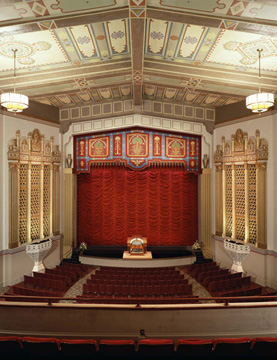
Restoring the theatre took another $6 million and nearly two years. Bringing it back to its 1925 appearance required extensive research and painstaking attention to detail. The theatre is colorfully decorated in a Greek and Assyrian style of plaster and painting. Once again a colorful decorative tapestry frames the stage and six great chandeliers hang overhead. When the lush red main drape rises before a show, it reveals a silvery-rose title curtain which pulls aside to open each film with a distinctive flourish. No expense was spared, and even the seats are covered in fine red wool mohair.
With seating for 1,175 and a steeply-tiered balcony section, the theatre combines the elegance of a 1920s movie palace with the projection and sound quality expected by today's audiences. Its large screen can accommodate 35mm VistaVision and other widescreen formats. A magnificent 1926 Wurlitzer organ rises from the orchestra pit during intermissions. It came from Grauman's Chinese Theater in Hollywood, which is famous for its movie star handprints and footprints in cement. Most nights include a double-feature as well as a live performance on the organ before and after the 7:30 show.
The Stanford reopened on December 8, 1989. It sold nearly one million tickets in its first six years of operation after restoration. More people saw the 50th anniversary re-release of Casablanca at the Stanford than anywhere else in the country. Now approaching their twentieth anniversary as a restored movie house, they have screened over 2,100 films.
It's operated by the Stanford Theatre Foundation, a non-profit that still receives funding from the Packard Humanities Institute. The foundation was established to promote the preservation, study, and public appreciation of classic American films. Using a festival format for its programming, many of Hollywood's great stars have made personal appearances at the Stanford. Some of these include Billy Wilder, Jack Lemmon, Eva Marie Saint, Alice Faye, Ruby Keeler and Douglas Fairbanks, Jr.
Besides operating the theatre, the foundation also holds an archive of more than 1,000 silent films and is actively involved in film preservation. According to Charles Hopkins at the UCLA Film & Television Archive, "the early and continuing support of the Packard family foundations…has done much to raise public awareness of the importance of film preservation." This helped to generate a climate of enthusiasm for preserving and restoring films, including the 12 Basil Rathbone Sherlock Holmes films produced by Universal Pictures.
Stanford Theatre Sherlock Holmes Film Festival
In 2001 the Stanford held a Sherlock Holmes film festival. That year was the centennial of the first publication of The Hound of the Baskervilles in the Strand Magazine. In August 2001, I wrote a letter to David Packard mentioning the centennial and suggesting that the theatre show the Rathbone Hound and perhaps some other Holmes films. It was quite a thrill to see them put on an extended Sherlock Holmes festival from October to December 2001 that included The Hound and nine of the top ten Rathbone Holmes movies. The theatre sold more than 10,000 tickets for this Holmes festival.
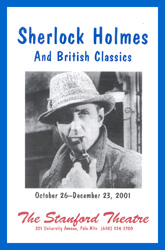
The 2001 Festival Program
The Hound of the Baskervilles (1939)
Sherlock Holmes and the Secret Weapon (1943)
Sherlock Holmes Faces Death (1943)
The Spider Woman (1944)
The Scarlet Claw (1944)
The Pearl of Death (1944)
The House of Fear (1945)
The Woman in Green (1945)
Terror by Night (1946)
70 Year Anniversary of Basil Rathbone as Sherlock Holmes
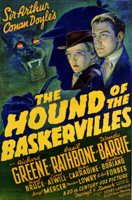
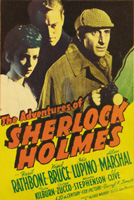
It's now the seventieth anniversary of Rathbone's Hound of the Baskervilles and the perfect occasion to show it again. This time it will be part of a double-feature that includes Rathbone's only other Victorian-period Holmes film. That movie, The Adventures of Sherlock Holmes, did not play in the 2001 festival and is often overshadowed by The Hound.
However, critics and reviewers generally consider The Adventures to be at least as good as The Hound, and some rate it as the best of the Rathbone films. It's loosely based on William Gillette's play. The film does include Professor Moriarty, portrayed by an excellent George Zucco, but most of the plot is new. Although the studio apparently cut a few minutes from the film, leaving some plot holes, the movie remains highly enjoyable with strong production values and fine cinematography
The American Film Institute (AFI) also credits that picture with one of the top 100 movie quotations of all time. The AFI selected "Elementary, my dear Watson" as number 65 on their list, but many Sherlockians may be surprised by the AFI's attribution of it to The Adventures. Clive Brook first spoke the phrase on-screen in the 1929 film The Return of Sherlock Holmes. Of course, Rathbone said it frequently in the 1940s Holmes films and he is probably the best-known Holmes of the movies.
Rathbone's first two Sherlock Holmes films came out during Hollywood's Golden Year of 1939. Gone with the Wind topped the box office that year with The Wizard of Oz capturing second. Others in the top ten included Ninotchka, Mr. Smith Goes to Washington, and The Hunchback of Notre Dame. Stagecoach, Beau Geste, The Four Feathers, and Gunga Din all provided superior action and adventure for moviegoers in 1939. At any other time the Holmes films might well have been considered to be in the top ten movies of the year, but even in that greatest year of movies, both of the Rathbone Holmes films could reasonably be judged to be among the top twenty. Rathbone went on to make twelve more Holmes films, but these two rank highest on the list of the Top 10 Basil Rathbone Sherlock Holmes Movies.
2009 Holmes Double-Feature
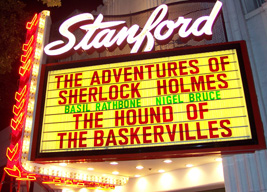
On August 25-27, 2009, the Stanford Theatre showed a double-feature of Basil Rathbone's two best Sherlock Holmes movies. The Hound of the Baskervilles appeared twice nightly at 6:00 and 9:05, and The Adventures of Sherlock Holmes began at 7:30. I attended on Thursday August 27 with several other Bay-area Sherlockians, and along with a very respectable crowd we enjoyed seeing these films on the big screen. The print for The Adventures of Sherlock Holmes was especially clean and clear, with very few scratches or defects. Both movies played at the Stanford Theatre in 1939, and this 70th anniversary showing provided a rare chance to see the films at their best in a wonderful setting.
Sherlock Holmes lived at 221B Baker Street, and thus Sherlockians will appreciate the Stanford Theatre's location at 221 University Avenue in downtown Palo Alto, California. The main Palo Alto Caltrain station is within easy walking distance. Free parking is available after 5:00 PM at large parking structures within two blocks of the theatre. One structure is a block north on Bryant Street and the other is a block south on High Street.
Credits
For more details on the theatre, its history, and current program see The Stanford Theatre website.
Photo of theatre interior courtesy of The Stanford Theatre Foundation.
My thanks to Cyndi Mortensen at The Stanford Theatre Foundation and to Charles Hopkins at the UCLA Film & Television Archive for patiently answering my many questions. And of course special thanks to David Woodley Packard for bringing us great movies in a great setting.
Vers. 2.0ax-RN Original work
Copyright ©2015
Randall Stock. All Rights Reserved.